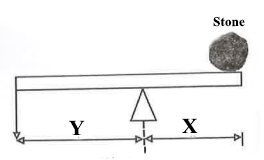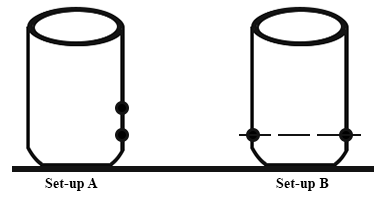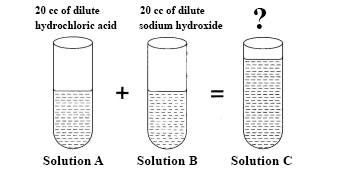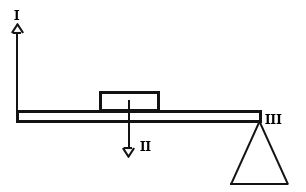1.
Hydrogen is represented by the chemical symbol H2. This symbol represents
two molecules of hydrogen.
two atoms of hydrogen.
two elements of hydrogen.
two ions of hydrogen.
2.
A metal expands when there is
an increase in heat energy.
an increase in number of electrons.
a decrease in potential energy.
a decrease in distance between atoms.
3.
A safety device which opens an electric circuit to prevent too much current from passing through the circuit is the
earth wire.
lightning conductor.
fuse.
switch.
4.
An object is placed 20 cm in front of a plane mirror. The distance between the object and the image is
20 cm.
40 cm.
60 cm.
80 cm.
5.
In which of the following circuit diagrams below will the bulb light?




6.
The source of all forms of energy can be traced to
clouds.
earthquakes.
tides.
sunlight.
7.
When mango is falling from a tree, its potential energy is changed to
sound energy.
heat energy.
kinetic energy.
chemical energy.
8.
Electricity is used by appliances to do work. This means that electricity is a form of
energy.
force.
generator.
machine.
9.
A force of 2N moves a body through a distance of 10 m. Calculate the work done.
5 J
8 J
12 J
20 J
10.
The diagram below shows a lever system used to move a stone. Use it to answer the question below

The distance X is the
effort distance.
load distance.
fulcrum.
lever arm.
11.
The diagram below shows a lever system used to move a stone. Use it to answer the question below

Less effort is required to move the stone when the
distance Y is equal to X.
distance Y is greater than X.
distance Y is less than X.
stone is at the pivot.
12.
An omnivore is an animal that feeds on
raw food.
fresh foods.
cooked foods.
all kinds of food.
13.
A meal containing all the essential nutrients in the right amounts is said to be
delicious.
balanced.
well-cooked.
rich in fibre.
14.
The disease associated with insufficient in-take of proteins in children is
goitre.
kwashiorkor.
rickets.
scurvy.
15.
When testing for proteins in a food substance using Fehling's solution, the expected colour change is
blue.
purple.
blue-black.
brick-red.
16.
The substance that enables green plants to trap sunlight for the manufacture of food is
chlorophyll.
chloroplast.
phloem.
xylem.
17.
In man, the conversion of poisonous substances into harmless forms takes place in the
bladder.
duodenum.
kidney.
liver.
18.
Which of the following life processes is represented by the equation below?
Glucose + Oxygen → Water + Carbon dioxide + Energy
Digestion
Excretion
Photosynthesis
Respiration
19.
Chlorine gas is passed through water during filtration to
kill germs.
cause suspended particles to settle.
soften the water.
give taste to the water.
20.
Arrange the following sources of water in the order of increasing contamination.
I. Rain
II. Stream
III. Well
IV. Borehole
I, II, IV, III
II, III, I, IV
I, IV, III, II
III, II, IV, I
21.
A solution in which no more solute will dissolve at a given temperature is said to be
concentrated.
dilute.
homogeneous.
saturated.
22.
A clear solution of sugar was cooled from 100oC to 25oC. Some solid sugar was seen to have formed out of the solution after the cooling. This shows that sugar
does not dissolve in cold water.
does not dissolve in hot water.
dissolves more in hot water than in cold water.
dissolves more in cold water than in hot water.
23.
Water is sometimes referred to as a universal solvent because it
is the purest liquid on earth.
is the commonest liquid on earth.
is found in all living cells.
dissolves most substances.
24.
The charge of sulphur in the compound SO2 is
-2
+2
-4
+4
25.
The part of the soil that supports plant growth is that part which
dissolves in water.
retains less water.
contains the humus.
is closer to the roots.
26.
Plants do not grow well in gravel because the
air spaces are too big to hold water.
air spaces are too small for the roots.
particles cannot absorb air.
particles cannot contain nutrients.
27.
Which of the following parasites lives in the blood of humans?
Louse
Plasmodium
Tapeworm
Tick
28.
The carrier of the malaria parasite is the
black fly.
tsetse fly.
female anopheles mosquito.
male anopheles mosquito.
29.
Which of the following practices is a method of controlling guinea worm disease?
Clearing bushes around homes
Ensuring that rivers flow rapidly
Protecting one's feet before stepping into rivers
Protecting one's self against mosquito bites
30.
The humidity of the atmosphere is measured with
an anemometer.
a barometer.
a hygrometer.
a hydrometer.
31.
How long does it take the moon to move completely around the earth?
1 day
28 days
30 days
365 days
32.
Steel is an example of a
solid in solid mixture.
solid in liquid mixture.
gas in solid mixture.
liquid in liquid mixture.
33.
Which of the following elements is a metal?
Carbon
Nitrogen
Sulphur
Sodium
34.
Metals that are usually used to make ornaments have low
conductivity.
ductility.
malleability.
reactivity.
35.
The food processing method in which germs are prevented from multiplying by applying a low temperature is
canning.
drying.
pickling.
refrigeration.
36.
The function of blood platelets is to
carry carbon dioxide.
fight against diseases.
help in clotting.
help maintain constant body temperature.
37.
A fish is able to swim with little resistance in water because it has
fins.
gills.
a streamlined body.
the ability to make use of a limited oxygen supply.
38.
When a person jumps up, he/she is able to come down because of the
pull of the earth's gravitational force.
pull of the earth's magnetic force.
resistance of the earth's atmosphere to the upward motion.
pressure of the earth's atmosphere on the person.
39.
A metal displaces 5.0 cm3 of water when completely immersed in water. If the mass of the metal is 35.0 g, calculate its density.
7.0 g cm-3
30.0 g cm-3
40.0 g cm-3
175.0 g cm-3
40.
Oxygen from the air is able to get into the blood by
capillarity.
diffusion.
osmosis.
suction.
(a)

In an experiment, a pupil took two empty Milo tins and made holes in their sides as shown in the diagram above. The pupil then filled the Milo tins with water.
(i)
Draw and label the diagrams to show what the pupil will observe in set-up A and set-up B.
(ii)
Explain the observations in set-up A and set-up B.
(iii)
What is the aim of set-up A?
(iv)
What is the aim of set-up B?
(b)
In an experiment, equal volumes of dilute hydrochloric acid (Solution A) and dilute sodium hydroxide (Solution B) are mixed together to form solution C.

(i)
What is the volume of solution C?
(ii)
Red litmus paper and blue litmus paper are dipped in turns into solutions A, B and C.
State the observations you will make in all six cases.
(iii)
Give the name of the reaction that took place between solution A and solution B.
(iv)
Identify solution C
(v)
State what will happen when solution C is heated.
(c)
The table below gives the steps that were followed in an experiment to test for starch in a green leaf freshly taken from a tree.
| Stages in the test for starch |
|
I. Leaf is put into boiling water for 1 minute II. Leaf is dipped in alcohol warmed in a hot water bath III. Leaf is washed in cold water IV. Leaf is dipped into iodine solution |
(i)
State the reason for carrying out each of the activities in stages I, II and III.
(ii)
What happens when the leaf is dipped in iodine solution?
(iii)
Give the colour changes of the leaf from the beginning of the experiment to the end of the experiment.
(iv)
Why is the alcohol warmed indirectly in a water bath?
(vi)
Explain what will be observed if the test is carried out on a leaf taken from a plant kept in a dark room for 1 day
(a)
(i)
Define respiration.
(ii)
Give two differences between photosynthesis and respiration.
(b)
(i)
List the chemicals used in the preparation of carbon dioxide in the laboratory
(ii)
How would you test for carbon dioxide in the laboratory?
(c)
(i)
State four effects of a force on a body.
(ii)
A horizontal force of 250 N is applied to pull a piece of wood lying on a smooth surface through a distance of 20 m.
Calculate the work done.
(a)
(i)
Give two differences between a vein and an artery.
(ii)
State two functions of red blood cells.
(iii)
Mention two diseases associated with the circulatory system.
(b)
(i)
Classify the following processes into a physical change and a chemical change:
Cooking of food;
Melting of candle;
Melting of ice;
Rusting of iron;
Dissolution of sugar in water;
Burning of wood into ash.
(ii)
Explain the basis of the classification in (b)(i).
(c)
(i)
State the laws of reflection.
(ii)
Draw a ray diagram of light incident at an angle of 40o on the surface of a plane mirror.
(a)
(i)
Explain vegetative reproduction
(ii)
State two differences between sexual reproduction and vegetative reproduction.
(iii)
Give one advantage of vegetative reproduction.
(b)
(i)
Name suitable solvents for the following substances:
oil paint, fat, common salt, plant pigments.
(ii)
What is the name given to a substance dissolved by a solvent?
(c)
The diagram below represent a simple machine.

(i)
What class of simple machine does it represent?
(ii)
Name the parts labelled I, II and III
(iii)
Give two examples of machines used in everyday life which work on the same principle as the system illustrate above.
(a)
(i)
Give two differences between a parasite and a vector.
(ii)
Write down the names of three endo-parasites and their hosts.
(b)
An atom has eight protons and nine neutrons.
(i)
Draw the atomic structure of the atom.
(ii)
If the atom gains two extra electrons what will be the charge of the ion formed? (Show working)
(c)
(i)
Three insoluble liquids X, Y and Z are shaken together in a bottle and allowed to settle.
The densities of the liquids are as follows:
X = 1.5 g/cm3
Y = 3.0 g/cm3
Z = 1.0 g/cm3
Draw a sketch to show the various layers into which the liquids settle.
(ii)
The density of petrol is 0.9 g/cm3.
Calculate the volume of 300 g of petrol.